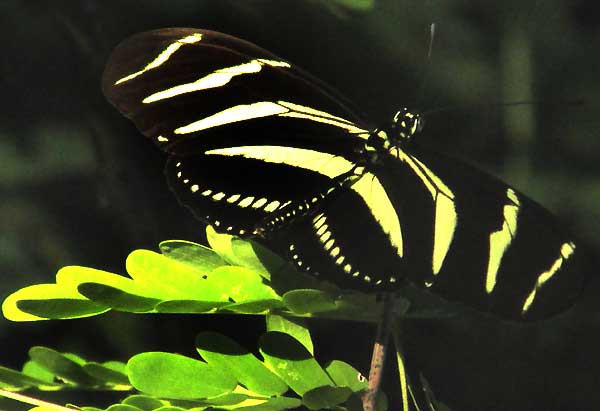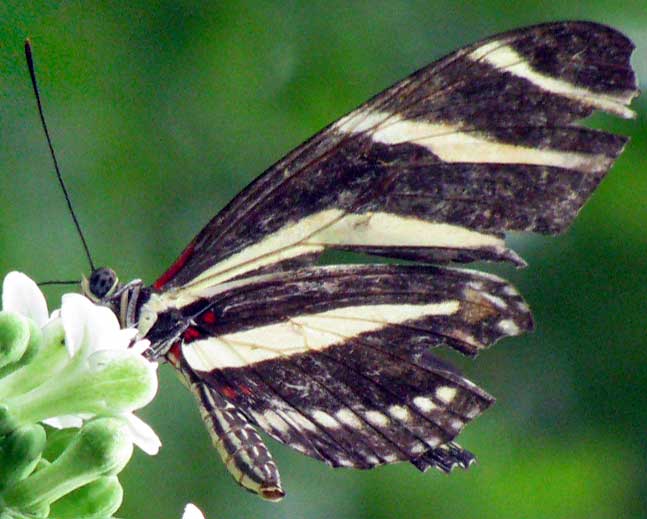Excerpts from Jim Conrad's
Naturalist Newsletter
issued on September 23, 2019 from near Tepkán, Yucatán, MÉXICO
ZEBRA HELICONIAN
When the Zebra Heliconian, HELICONIUS CHARITHONIA, spreads its wings, it looks like this:

The stripes were yellow, but in photographs often the yellowness shows up as white. The species is common here.
from the June 27, 2010 Newsletter issued from Hacienda Chichen Resort beside Chichén Itzá Ruins, central Yucatán, MÉXICO
ZEBRA HELICONIAN
A fair-sized butterfly subfamily known as the Longwings, the Heliconiinae, contains species that typically have long, narrow wings, bright colors and a buoyant, slow, tiptoeing manner of flying. During the dry season I didn't see any here but now that it's raining fairly regularly you see the species shown below.

That's the Zebra Heliconian, HELICONIUS CHARITHONIA, maybe the most widely spread and common of the group. It's a permanent resident from southern Texas and peninsular Florida all the way through here and the West Indies into South America. In the US sometimes it makes surprise appearances in places like Nebraska and South Carolina, where its sighting is considered something special.
Along trails, in the garden and at woods edges you see males patrolling for females. Their patrolling seems to be of a casual kind as they float daintily on narrow, fragile-looking wings about 3.5 inches across (9 cm). However, the males themselves take no prizes for chivalry. Male Zebra Heliconians have been observed waiting next to female Zebra Heliconian chrysalises -- the pupating resting stages between caterpillar and adult -- and mating with the female as she is about to emerge. Then he deposits a chemical on her abdomen that repels other males!
Caterpillars eat passion-vines, of which we have an abundance here.
from the January 5, 2007 Newsletter issued from Sierra Gorda Biosphere Reserve, QUERÉTARO, MÉXICO
ZEBRA LONGWING BUTTERFLIES ON A COLD MORNING
Over the long New Year weekend I camped in the mountains just outside Jalpan. Yet another norther was moving through so the first hours of 2007 found me in a cold, wet tent. I'd prepared for it, however, and at dawn on New Year's Day it was cozy lying in my sleeping bag gazing into the misty valley below. Green Jays orbited around the tent giving me the eye, squawking and flashing their yellow undertails.
![]() The drizzle ended and I went snooping. Often on such chilly days you can find critters who on a warmer day would be moving too fast to get a good look at. That was exactly the case with the three Zebra Longwing Butterflies, HELICONIUS CHARITONIUS, I found clinging upside-down beneath a gray, epiphytic bromeliad, as shown at the right.
The drizzle ended and I went snooping. Often on such chilly days you can find critters who on a warmer day would be moving too fast to get a good look at. That was exactly the case with the three Zebra Longwing Butterflies, HELICONIUS CHARITONIUS, I found clinging upside-down beneath a gray, epiphytic bromeliad, as shown at the right.
I've been hoping to get a good picture of this species because they're common here, and very dissimilar to most butterflies up north because their wings are so long and slender. When these butterflies fly, their movement seems more buoyant, more fluttery, than that of our broader- winged species. When I see a Heliconius with its tiptoeing-like flight sailing along before a wall of lush, dark-green vegetation I really get that tropical feeling. In fact, the whole genus Heliconius is mainly a tropical one, with about 40 species.
One ecological curiosity about the species is that although its caterpillar form seems able to survive in the forest, the adult form can't compete with other forest species, and is thus fairly restricted to disturbed sites. It's a weedy-area specialist. Though sometimes thought of in the US as a Passionvine Butterfly, here its main host plants are Lantana, Hamelia and Stachytarpheta.